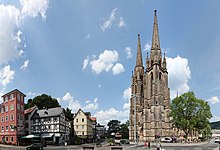St. Elizabeth's Church, Marburg
This article includes a list of general references, but it lacks sufficient corresponding inline citations. (September 2022) |

St. Elizabeth's Church (Elisabethkirche) in Marburg, Germany, was built by the Order of the Teutonic Knights in honour of Saint Elizabeth of Hungary.[1] Her tomb made the church an important pilgrimage destination during the late Middle Ages.
Architecture


The church is one of the earliest purely Gothic churches in German-speaking areas, and is held to be a model for the architecture of Cologne Cathedral. It is built from sandstone in a cruciform layout. The nave and its flanking aisles have a vaulted ceiling more than 20 m (66 ft) high. The triple choir consists of the Elisabeth choir, the High choir and the Landgrave choir. The crossing is separated from the nave by a stone rood screen. In earlier times, the front part of the church had been reserved for the knights of the Order. The church has two towers with an approximate height of 80 m (263 ft). The northern one is crowned by a star, the southern one by a knight. It served as an inspiration for St. Paul's Church in Strasbourg.
The Gothic shrine of St. Elizabeth is the most important treasure of the church, but other pieces of religious art are also exhibited.
History

Construction started in 1235, the year Saint Elizabeth was
Until the 16th century, the
Most of the knights and clerics of the Order who were attached to the church converted to
After World War II, former German president Paul von Hindenburg and his wife were buried in the Elizabeth Church, after the removal of their remains from a salt mine where they were hidden under orders of their son Oskar von Hindenburg to protect them from Soviet Forces, later to be found by the US Army, and finally put to rest in this 13th-century church.
Recent developments
This section needs to be updated. (April 2022) |
In order to start a long-needed renovation of the church and the remodelling of its immediate neighbourhood, the Stiftung Heilige Elisabeth
In 2023 it was reported that renovation work was underway on the stained glass in the church. [2]
See also
References
- ^ "Church of St. Elizabeth, Marburg". Religiana. Retrieved 2022-09-15.
- ^ Elizabethkirche. "Zwischenstand zur Renovierung".
{{cite web}}: CS1 maint: url-status (link)
- Hermann Bauer: Sankt Elisabeth und die Elisabethkirche zu Marburg. Marburg, Hitzeroth 1990 ISBN 3-89616-031-1(in German)
- Andreas Köstler: Die Ausstattung der Marburger Elisabethkirche. Zur Ästhetisierung des Kultraums im Mittelalter. Berlin, Reimer 1995 ISBN 3-496-01134-3(in German)
- Eberhard Leppin: Die Elisabethkirche in Marburg an der Lahn. Königstein, Langwiesche 1999 ISBN 3-7845-2913-5(in German)
External links
- St. Elizabeth's Church (in German)
